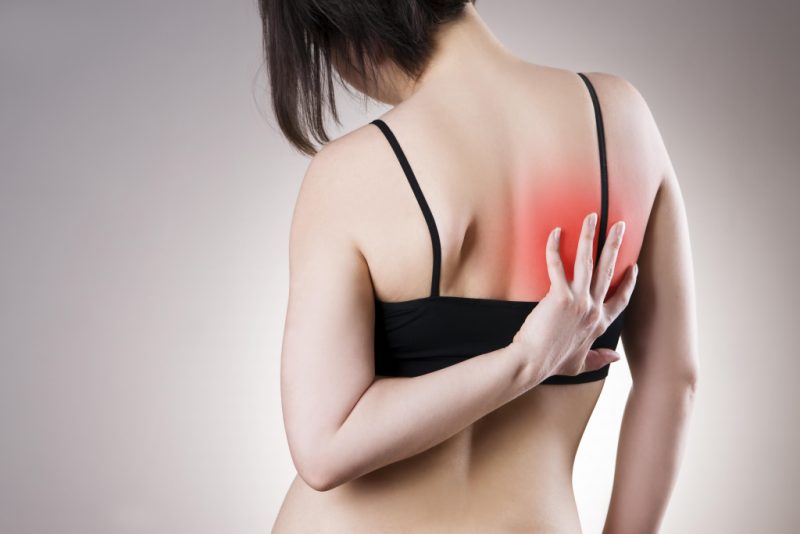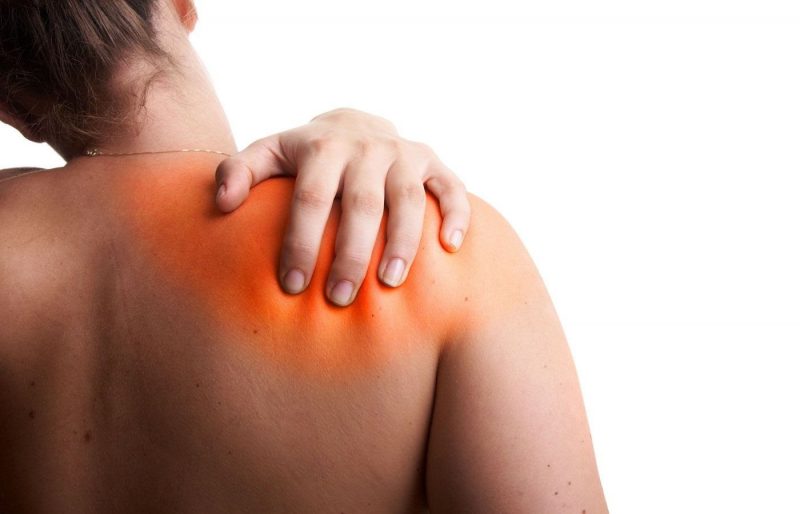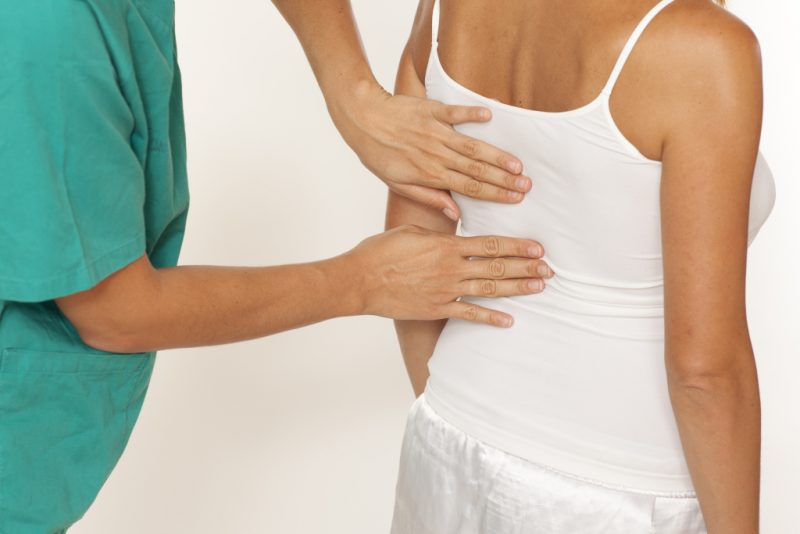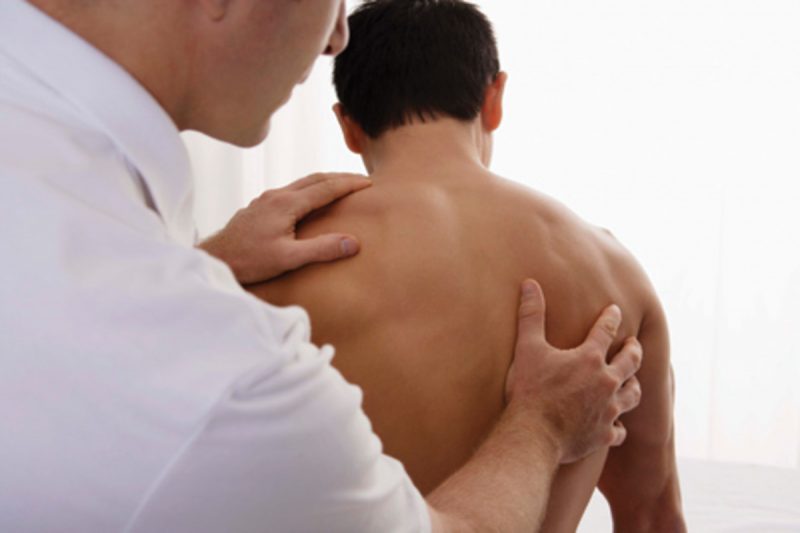It is always difficult to diagnose the causes of pain under the right scapula from behind from the back, since this symptom accompanies many diseases, including a fracture of the scapula. So problems with the spine, internal organs, or nerve endings located between the ribs may occur. Therefore, it makes sense to give information on this topic in more detail.
Material Content:
About the causes of pain under the shoulder blade on the right side of the back

Soreness in this place can be caused by the presence of certain pathologies:
- disorders of the motor system;
- ailments of the bile ducts and gall bladder;
- gastric and renal pathologies;
- subphrenic abscess and lung disease;
- intercostal neuralgia and myofascial syndrome.
The danger of localization of pain in this place is its appearance in remoteness from the real pathological process. This is explained by the presence of many nerve endings that contribute to the transmission of a signal from a sore spot. It is repercussion or reflection syndrome that makes the diagnostic process difficult.
This effect does not allow you to independently diagnose and establish the cause of the pain, because directly under the scapula any internal organs are not located. Therefore, the diagnosis should be comprehensive and professional.
What diseases causes pain?
Uncomfortable sensations in the area under discussion can result from damage to the vertebrae of the cervical or thoracic sections, nerve endings located between the ribs, back muscles, or even a lung with pleura. Organs located at some distance can cause similar pains - the gall bladder, the kidney on the right, the diaphragm.

There are many diseases that can provoke such pain. Thus, it may manifest:
- Osteochondrosis, spondylosis and herniated discs in the thoracic region. This is usually a constant or periodic aching sensation. The cause of discomfort is excessive physical effort or a long stay in one position. Additionally, a crunch may appear in the spine during a sharp turn. Perhaps the sensation of numbness of the fingertips. Injury of nerves in osteochondrosis and hernias is accompanied by very strong, burning pain, aggravated by movement.
- Pleuropneumonia and pleurisy, when lung tissue becomes inflamed, leading to stitching pain. Another manifestation of pleuropneumonia is a dry nagging cough, discharge with mucus and pus, as well as a jump in body temperature up to 39-40 degrees. With pleurisy, the pain will be stitching, becoming even more noticeable when you try to cough, sneeze, or even just inhale. You can alleviate the condition if you lie on your right side.
- Myositis. This is called inflammation of the muscles, in this case, forming the shoulder girdle. The pain and severity of pain in this disease increases during the torso to the left. The reasons for the development of such an ailment are an awkward sharp movement, hypothermia or prolonged exposure to a draft.
- Cholecystitis and gallstones. These diseases are also accompanied by pain on the right in the back. If we talk about the first disease, then it causes a dull aching sensation, which becomes even brighter, after an hour and a half after eating fatty, spicy, salty or spicy foods. Additional symptoms of the disease are constipation or diarrhea, gas formation and bitterness in the mouth in the morning. But cholelithiasis is characterized by intense cutting pain, frequent vomiting, flatulence, tachycardia, cold sweat, thirst, colorless feces and dark urine.
- Subphrenic abscess. This is the appearance of pus in the space between the liver and the diaphragm. It occurs due to perforation of a stomach ulcer or duodenum, complications after surgery in the abdomen or abscess of the liver. The pain is cramping and cutting, worse when breathing.
- Pyelonephritis and kidney stones. The intensity of pain on the right under the shoulder blade for these diseases is different. The first ailment is accompanied by a pulling pain that begins in the lumbar region and passes under the right scapula. The presence of stones in the bladder gives sensations that are cutting and shooting.
- An injured bone (scapula) can also cause aching pain, aggravated by tilting the body, arm movements and touching the scapula.
- Boils, carbuncles, abscesses can lead to osteomyelitis or inflammation of the bone. In this condition, the pain will be aching, twitching, aggravated at night.
All these diseases should be diagnosed in a short time for the timely provision of qualified medical care. If you do not consult a doctor on time, you can not avoid the negative consequences.
Diagnostic Methods
The first thing to do when pain appears under the right shoulder blade is to make a diagnosis for the correct conduct of further therapeutic measures.

The doctor should interview the patient in detail, finding out the location and nature of the pain, and then, if necessary, prescribe an additional diagnosis:
- examination of feces and urine;
- X-ray
- Ultrasound
- MRI
- CT
Further, a consultation with a vertebrologist, cardiologist, neurologist, traumatologist and psychotherapist can be prescribed.
The nature of pain - what it is
A very significant point is the nature of the pain under the right scapula, which largely determines the correct diagnosis.
Dumb
Such sensations develop with nephritis or pyelonephritis in a chronic form (stage 2). Pain occurs of a periodic nature, extending to the lumbar region or upper torso. The disease is accompanied by painful urination, low-grade fever and sometimes nausea.

Dull pain occurs with chronic cholecystitis, as well as with oncology of organs located on the right side of the body.
Beginning cirrhosis of the liver can also be accompanied by dull right-sided pain, extending under the scapula.
Aching sensations
A common pathology of a modern person who spends half his life at his desk is osteochondrosis. This disease also leads to constant aching pain in the back right.
Inflammation of the back muscles, diseases of the kidneys, lungs, gall bladder, pancreas and liver also accompany such sensations.
Sharp, sharp pain
This kind of pain can indicate acute cholecystitis, movement of stones, dyskinesia of the ducts of the gallbladder.

Overeating, as well as exacerbation of gastric ulcers, peritonitis, rib injuries, pneumothorax, neuralgia and displacement of the intervertebral discs can also provoke such sensations.
Growing pain
Pain escalating accompanies cervical osteochondrosis. Pain sensations are aggravated by static load or sharp body turns.
Constant pain
A similar nature of pain occurs with tuberculosis and osteomyelitis, as well as pleurisy, pneumonia, bronchitis and renal pathologies.

Pain under the right shoulder blade when inhaling and exhaling
The pain of the discussed localization on inspiration develops with dry pleurisy, pericarditis, intercostal neuralgia, pathologies of the gallbladder, kidney abscess and pyelonephritis.
Which doctor should I go to?
To begin with, visit the therapist, and he will already be referred to specialists for making the correct diagnosis.

Your further route can be laid in the offices:
- gastroenterologist;
- neurologist;
- chiropractor;
- neurovertebrologist;
- cardiologist;
- nephrologist or urologist.
Treatment features
The appointment of treatment is done only by a doctor, for which, as mentioned above, it is necessary to make a diagnosis. Before that, it is recommended to use tablets, creams and ointments of analgesic effect to alleviate the condition.
You can not warm up a painful place, because if the cause is in the inflammatory process, then the situation will only worsen.
If the painful sensations were the result of inadequate physical activity or prolonged stay in the same position, then physiotherapy exercises and gentle massage will help.
Preventive actions
The main recommendation for the prevention of any disease is to regularly monitor your health, to prevent physical, mental and emotional stress.

- Lead an active lifestyle, daily walking for an hour or more in the fresh air and applying adequate physical activity in the form of simple and accessible exercises.
- Review your attitude to the foods you eat and if you are used to eating unhealthy foods (fast foods, pastries, sausages, canned goods and sweet soda), you should switch to a healthy diet. These are vegetables, fruits, stewed or boiled meat and fish, sour-milk products, honey, cheese, cottage cheese, green tea, dried fruit compote and natural juices.
Just be more attentive to your body and quickly respond to any changes in health. But without fanaticism - everything should be reasonable and adequate to the situation. Health to you and your loved ones!












